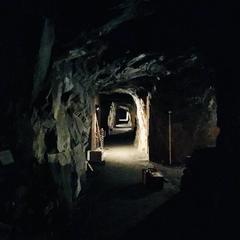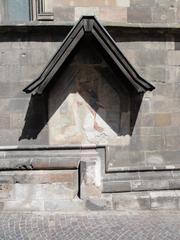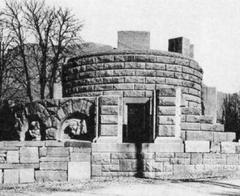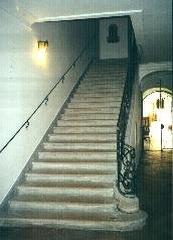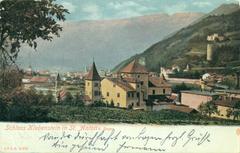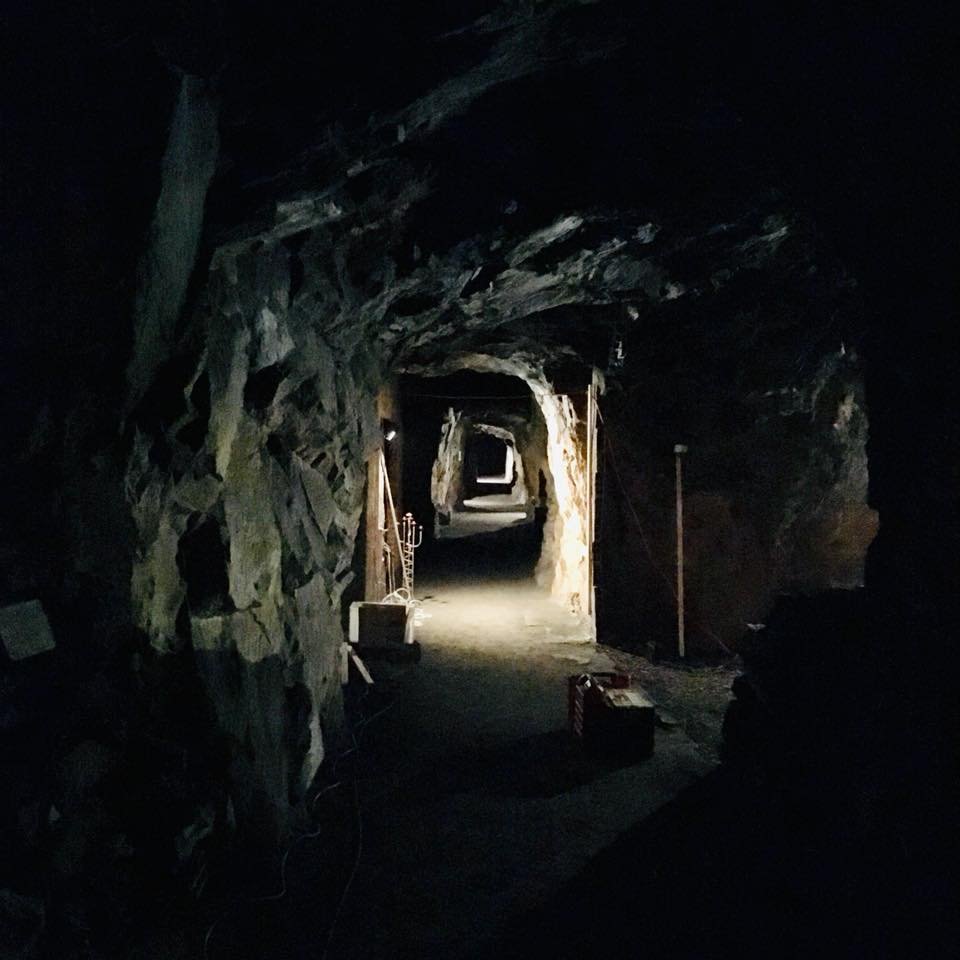
Bunker H Bolzano, Italy: Visiting Hours, Tickets & Historical Site Guide
Date: 14/06/2025
Introduction
Bunker H in Bolzano, South Tyrol, Italy, is a remarkable World War II-era underground complex carved beneath Monte di Mezzo and Guncina hill. Constructed between 1943 and 1944 by German forces and forced laborers, its over 7,000 square meters of tunnels served as a fortified command post, munitions depot, and air raid shelter during the Nazi occupation. Today, Bunker H stands as a testament to the region’s wartime history, postwar transformation, and contemporary cultural vibrancy. Visitors will encounter engineering marvels, fascinating geological features, and thoughtfully curated exhibitions, making it a must-visit for history enthusiasts, geology lovers, and cultural explorers alike (Travel with the Wind; Alto Adige; Salt & Wind; Bunker H Official Website).
Contents
- Construction and Strategic Purpose
- Engineering and Labor
- Wartime Use and Daily Life
- Postwar Abandonment and Rediscovery
- Physical Features & Artefacts
- Historical Significance
- Visiting Hours, Tickets & Tours
- Accessibility & Visitor Tips
- Preservation and Contemporary Use
- Frequently Asked Questions
- Summary & Key Points
- Sources
Construction and Strategic Purpose
Bunker H was built following the 1943 Italian armistice, when German forces occupied northern Italy. The bunker formed part of a defensive network protecting German command and logistics in the Alpine corridor, a vital link between Italy and Austria. Bolzano’s strategic location made it a target for Allied raids, so the bunker was designed to serve multiple roles: air raid shelter, command center, and depot for munitions and supplies (Salt & Wind).
Engineering and Labor
The construction of Bunker H was a monumental engineering challenge, achieved by excavating more than 7,000 square meters of solid porphyritic rock. Prisoners from the Bolzano transit camp (Lager di Bolzano) performed much of the manual labor under harsh conditions, removing debris by hand and wheelbarrow (Travel with the Wind). The complex featured a labyrinth of tunnels, rooms, and seven original entrances—now mostly sealed except for the main access on Via Fago. The bunker’s interior included reinforced living quarters, storerooms, and operational spaces, some with tiled floors and basic furnishings for high-ranking officers (Alto Adige).
Wartime Use and Daily Life
During WWII, Bunker H was used exclusively by German military personnel as a refuge from air raids, a command center, and a storage depot for munitions and seized valuables (Wikipedia: Italian Campaign). Officers occupied the rooms nearest to the entrance, while deeper sections housed storage and makeshift barracks. Its robust construction and strategic location made it a secure asset for occupation forces (Alto Adige).
Postwar Abandonment and Rediscovery
After the American liberation in 1945, the German garrison retreated and Bunker H was abandoned. The Italian military briefly reused the site during the early Cold War, but by the 1970s it was neglected and left open, becoming a site for urban legends and unauthorized activities. In recent years, community initiatives have restored Bunker H, opening it to guided tours and cultural events (Salt & Wind; Concrete Playground).
Physical Features & Artefacts
Bunker H’s tunnels, carved in ancient porphyritic rock, maintain a stable, cool climate year-round. Visitors will encounter natural phenomena such as stalactites, stalagmites, mineral waterfalls, reflective pools, and occasionally even eels (Alto Adige). Exhibited artefacts recovered during restoration—coins, buttons, and personal items—offer glimpses into the daily lives of the bunker’s wartime inhabitants (Travel with the Wind).
Historical Significance
Bunker H is a powerful symbol of South Tyrol’s WWII history: forced labor, occupation, and the militarization of the region (Salt & Wind). Its construction involved prisoners from the nearby transit camp, highlighting the human cost and complexities of the conflict (Travel with the Wind). Today, the bunker stands as a “place of memory,” fostering reflection on the past and its relevance to the present.
Visiting Hours, Tickets & Tours
- Opening Hours: Tuesday to Sunday, 10:00–17:00 (last tour at 16:00); closed Mondays and some holidays.
- Tickets: €8–€12 adults; discounts for students and seniors; free for children under 10.
- Booking: Advance reservation recommended via the official website.
- Tours: Guided tours last 60–90 minutes and are available in Italian, German, and English. Private group tours and educational visits can be arranged (Bunker H Tours).
Accessibility & Visitor Tips
- Access: Located on Via Fago, accessible by bus, taxi, or car (limited parking nearby).
- Mobility: Some sections have stairs and narrow passages; partial accessibility for visitors with mobility challenges—check details when booking.
- Dress: Wear sturdy shoes and a light jacket due to uneven, cool, and damp conditions.
- Nearby Attractions: Combine your visit with the South Tyrol Museum of Archaeology (home of Ötzi the Iceman) or a stroll through Bolzano’s historic center.
- Facilities: Basic restrooms available; no café or shop on-site.
- Photography: Allowed for personal use; flash and tripods prohibited.
Preservation and Contemporary Use
Since 2013, Bunker H has been managed by Cooperativa Talia, which has restored the tunnels and adapted them for public access while retaining their raw, historical character. The site now hosts art exhibitions, performances, and educational events. Its adaptive reuse demonstrates how military heritage can foster creativity, inclusion, and community empowerment (Salt & Wind; Concrete Playground; unibz.it).
Frequently Asked Questions
Q: How do I buy tickets?
A: Reserve tickets online via the Bunker H Official Website.
Q: Are English-language tours available?
A: Yes, upon request and subject to guide availability.
Q: Is Bunker H wheelchair accessible?
A: Accessibility is limited; contact the site for details.
Q: Can I take photographs inside?
A: Yes, for personal use (no flash or tripods).
Q: Is the site suitable for children?
A: Yes, but children must be supervised due to narrow passages.
Summary & Key Points
Bunker H encapsulates the military, geological, and cultural history of South Tyrol in one extraordinary site. Visitors experience original WWII infrastructure, rare mineral formations, and thoughtfully curated exhibitions, all within a setting that bridges the past and present. Advance booking and appropriate attire will help ensure a memorable and educational visit. The site’s ongoing transformation into a cultural venue demonstrates the power of community-driven preservation and adaptive reuse.
Sources
- Travel with the Wind: Bunker H di Bolzano
- Alto Adige: Bunker H, la città nascosta
- Salt & Wind: Bolzano Italy
- Concrete Playground: Bunker H Dolomites
- Bunker H Official Website
- Wikipedia: Italian Campaign (World War II)
- unibz.it: The Bunker Project
All information current as of June 14, 2025. For updates, consult the official Bunker H website or download the Audiala app for guided tours and cultural resources.
